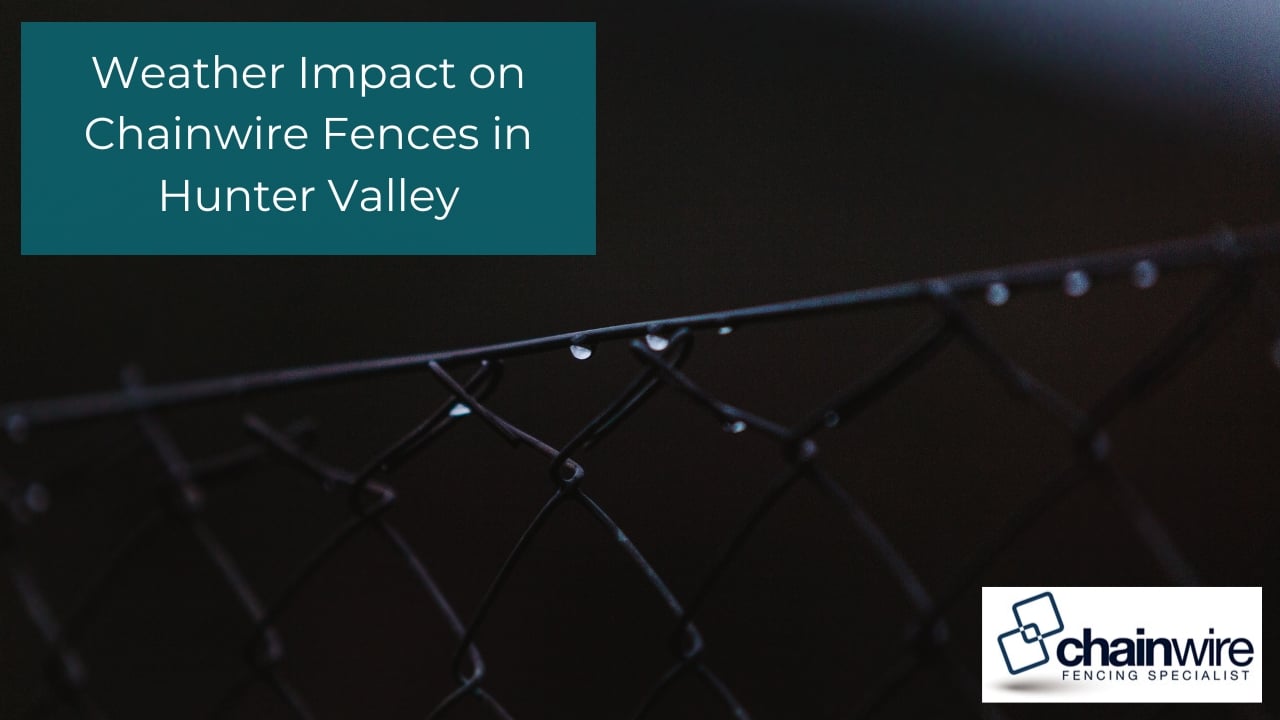Chainwire fences are widely used across the Hunter Valley because they are cost-effective, durable, and suitable for both residential and rural properties. But like all outdoor structures, they are exposed to changing weather conditions that can shorten their lifespan if not managed properly.
Prolonged heat, summer storms, and heavy rainfall each affect fencing differently. Without the right protection, UV rays may cause coatings to break down, while excess moisture can trigger rust or weaken posts. Over time, this leads to sagging, corrosion, or instability, reducing the fence’s ability to provide security.
The good news is that these issues can be prevented. With proper installation and ongoing maintenance, chainwire fencing in the Hunter Valley can withstand harsh weather while remaining secure and functional. This guide explains the main weather impacts, the risks they create, and the steps you can take to keep your fence in good condition year-round.
Hot Summers and UV Exposure
The Hunter Valley experiences long, hot summers with high levels of UV radiation. While chainwire fences are built for outdoor conditions, constant sun exposure will eventually take a toll. Heat and UV rays can cause protective coatings to fade, crack, or flake away. Once the steel underneath is exposed, rust becomes more likely.
Galvanised wire offers better protection because it is coated with zinc, which resists corrosion. For added durability, PVC-coated or powder-coated chainwire provides another layer against heat and UV damage. These coatings also reduce the amount of upkeep required over time.
Fence posts are equally vulnerable. Painted or untreated steel posts may degrade faster in areas with direct sun, which can weaken the structure. Using galvanised or powder-coated posts helps keep the entire fence stronger for longer.
Inspections carried out through summer help detect coating damage or exposed metal early. Prompt maintenance can extend the life of the fence and avoid costly replacements.

Rain, Humidity and Rust
Moisture is one of the main threats to chainwire fences in the Hunter Valley. Periods of heavy rain and seasonal humidity create conditions where rust can form quickly, especially when the protective coating is damaged or worn. Even small scratches on the wire or posts can become entry points for corrosion.
Once rust sets in, it gradually weakens the wire, making it more likely to snap under pressure. Posts can also lose strength as corrosion spreads below ground level where moisture collects. In time, this can compromise the stability of the entire fence.
Protective coatings such as galvanised or PVC finishes reduce the risk of corrosion, but they are not immune to wear. Touch-up paint or replacement of small sections can slow down rust before it spreads. Keeping vegetation clear from the fence line also helps reduce trapped moisture, which speeds up corrosion.
Frequent checks after periods of rain are recommended to identify early signs of rust and carry out timely maintenance. This helps extend the lifespan of the fence and maintain its strength in wet conditions.
Flooding and Soil Movement
Heavy rainfall and flash flooding are common in parts of the Hunter Valley, especially around creeks, rivers, or low-lying ground. When soil becomes waterlogged or washes away, fence posts may lose stability. A post that shifts even slightly can cause sagging, leaning, or gaps along the fence line. Over time, this reduces the security and overall strength of the structure.
Soil erosion around posts is one of the most common issues after major storms. Water movement removes the material that keeps posts firm, leaving them vulnerable to bending or collapse. Fences installed in flood-prone areas need additional reinforcement to withstand these conditions.
Setting posts deeper into the ground and securing them with concrete provides extra stability. Adding gravel or drainage channels along the fence line can also help water flow away instead of pooling at the base. These measures are especially important for agricultural or commercial properties where fencing must remain secure despite changing conditions.
Proactive planning during installation reduces the chance of failure, while inspections after heavy rain help identify areas needing reinforcement before further damage occurs.

Wind and Storms
Although the Hunter Valley does not experience extreme winds year-round, seasonal storms can cause significant stress on chainwire fences. Strong gusts push against the mesh, gates, and posts, testing the overall stability of the structure. If the fence has not been tensioned correctly or the posts are too shallow, damage can occur quickly.
Wide gate panels are particularly vulnerable as they act like sails in high winds. Poorly braced posts or loose fittings may bend, lean, or break under pressure. Once a single section weakens, the surrounding areas can also be compromised, reducing the security of the fence.
To minimise damage, fences should be installed with posts set deep in the ground and reinforced with concrete. Wire tensioning must be checked to ensure the mesh remains tight and able to withstand pressure from gusts. Bracing around gates and corners provides extra support in exposed areas.
Carrying out checks after major storms helps identify bent posts, loose fittings, or sagging mesh. Prompt repairs reduce the risk of further deterioration and extend the working life of the fence.
General Maintenance Tips
Chainwire fences in the Hunter Valley need consistent care because conditions shift between heat, storms, and rain. Inspections carried out after these events help identify issues early.
Key areas to check include
- Rust on wire or posts, especially at ground level or where coatings are damaged
- Mesh tension that becomes loose or sagging, which reduces strength and security
- Fence posts that lean or move in the soil, showing loss of support
- Vegetation such as vines, shrubs, or grass that hold moisture against the wire
- Dirt and leaf build-up that traps water and increases the chance of corrosion
Protective paint on exposed metal and replacing small damaged sections can prevent further deterioration. Applying these measures extends the working life of the fence and reduces the likelihood of large-scale repairs.
Need a Fence That Handles Hunter Valley Weather
Chainwire fences perform well when designed and maintained for local conditions, but heat, rain, and storms in the Hunter Valley make professional installation important. Choosing galvanised or coated wire, setting posts deep in the ground, and carrying out upkeep all help extend the life of a fence.
If you are considering a chainwire fencing specialist in Newcastle, working with experienced installers ensures the right materials and methods are used for the climate. Specialists can also provide guidance on placement and reinforcement for flood-prone or exposed sites.
For repairs, upgrades, or a new installation, you can contact us to discuss the most suitable fencing options. With the right planning, a chainwire fence will remain secure and reliable across the seasons.
Frequently Asked Questions
Will plants growing on my fence reduce its durability?
Yes. Vines, shrubs, and tall grass trap moisture against the wire. This increases the chance of corrosion during wet seasons. Keeping the fence line clear helps reduce damage.
Does fence direction make a difference to weathering?
It can. Fences facing full sun may experience faster coating breakdown, while shaded areas stay damp longer after rain, increasing rust risk. Orientation should be considered at installation.
Which post materials work best in the Hunter Valley?
Galvanised steel and aluminium posts last longer than untreated steel or timber. These materials are better suited to high-moisture and flood-prone ground conditions.
When is the best time to install a chainwire fence?
Late winter to early spring is often recommended. The ground is softer from winter rain but not waterlogged, and installation avoids the extreme heat and storms of summer.

